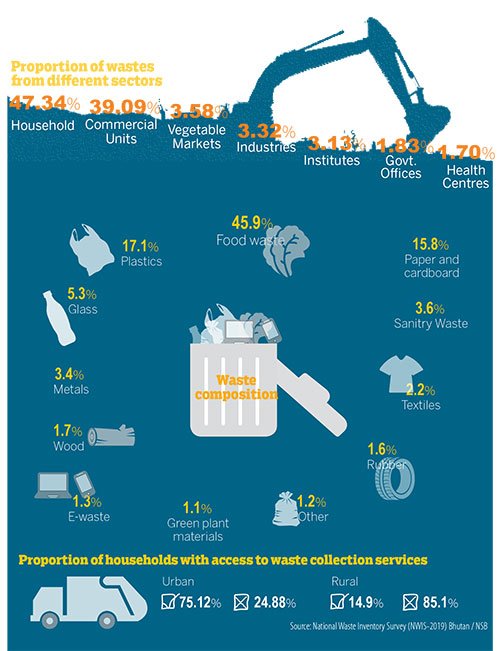Chimi Dema
Even as half of the country’s solid waste generated every day comes from households, about 65 percent of the households do not have access to waste collection service.
One-fourth of the households in urban areas are without access to the service. The figure is as high as 85 percent in rural areas.
The country’s first national waste inventory survey (NWIS-2019) reveals some glaring issues in waste management.
While eight in 10 households reported that they segregated waste at source, more than half the households said that they either dump waste in pit or burn it.
In rural areas, more than 55 percent of the households still resort to disposing of their household waste in the pit or burn them in the open due to lack of collection service.
Of the total households with access to waste collection services, more than 93 percent used the service.

Inappropriate timing and location of waste collection points being far or inconvenient were the two main reasons for not availing the services, according to the report.
The survey conducted by National Statistics Bureau National Environment Commission Secretariat (NECS) shows that the households generate about 81,000 kilogrammes (kg) of solid waste every day.
On average, each household generates around 0.5kg of solid waste a day.
The survey found that an urban household produces 0.7kg of waste a day, almost double the amount of 0.4kg that a rural household produces.
Half of the total solid waste from the households was food waste, followed by plastics at 20 percent.
In both urban and rural areas, plastics and sanitary wastes constituted almost six percent of the total waste. Electronic waste was the least going by waste type, at less than one percent of the total household waste.
Besides household, the survey also gathered waste-related statistics from commercial units, health centres, institutes and other relevant sectors from seven dzongkhags, mainly to provide appropriate waste-related data for planning and executing well-informed waste management programmes and activities.
Of the total 172,161kg of solid waste that the country generates in a day, the second-highest proportion after households comes from commercial units, which is almost 40 percent.
The survey revealed that about 46 percent of total waste composition comprises of food waste, indicating the potential for composting. Plastic and paper waste make up 33 percent of the total waste, indicating potential for recycling and reuse.
The total waste commercial units generated a day was estimated at around 67,299kg, where one-third comprised of food waste.
The highest composition of waste from vegetable vendors, institutes and health centres was also found to be food waste at over 70, 38, and 33 percent respectively.
Apart from toxic and hazardous waste, industries produce about 5,719kg of waste every day, with each industry generating about 16kg of waste each day.
About 40 percent of industry waste comprises of paper and cardboard products, followed by food waste at 23 percent and plastics, about 13 percent.
According to the report, some of the challenges facing the industries in waste management were the lack of waste storage facility, proper disposal sites and collection services.
“A majority of the industries reported lack of awareness of relevant sections in the environmental Acts and regulations,” the report stated.
Meanwhile, several private waste companies collect about 437.360 metric tonnes of waste every week where 28 percent comprises of wet waste, 31 percent of recyclable, and 40 percent is non-recyclable.
However, lack of government support, labour shortage and budget constraints, and unawareness on waste management were some of the issues these companies face when it comes to deal effectively with waste, according to the report.
The survey was supported by German Federal Ministry for the Environment, Nature Conservation, Building and Nuclear Safety and United Nations Environment Programme through World Wildlife Fund (WWF) Bhutan.

